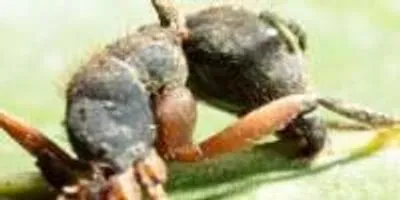A parasitic fungus that must kill its ant hosts outside their nest to reproduce and transmit their infection, manipulates its victims to die in the vicinity of the colony, ensuring a constant supply of potential new hosts, according to researchers at Penn State and colleagues at Brazil's Federal University of Vicosa.
Previous research shows thatOphiocordyceps camponoti-rufipedis, known as the "zombie ant fungus," controls the behavior of carpenter ant workers -- Camponotus rufipes -- to die with precision attached to leaves in the understory of tropical forests, noted study lead author Raquel Loreto, doctoral candidate in entomology, Penn State's College of Agricultural Sciences.
"After climbing vegetation and biting the veins or margins on the underside of leaves, infected ants die, remaining attached to the leaf postmortem, where they serve as a platform for fungal growth," Loreto said.
The fungus grows a stalk, called the stroma, which protrudes from the ant cadaver. A large round structure, known as the ascoma, forms on the stroma. Infectious spores then develop in the ascoma and are discharged onto the forest floor below, where they can infect foraging ants from the colony.
This fungal reproductive activity must take place outside the ant colony, in part because of the ants' social immunity, which is collective action taken to limit disease spread, explained study co-author David Hughes, assistant professor of entomology and biology, Penn State.
"Previous laboratory studies have shown that social immunity is an important feature of insect societies, especially for ants," Hughes said. "For the first time, we found evidence of social immunity in ant societies under field conditions."
The researchers tested social immunity by placing 28 ants freshly killed by the fungus inside two nests -- 14 in a nest with live ants and 14 in one with no ants. They found that the fungus was not able to develop properly in any of the 28 cadavers. In the nest with live ants, nine of the 14 infected cadavers disappeared, presumably removed by the ants in an effort to thwart the disease organism.
"Ants are remarkably adept at cleaning the interior of the nest to prevent diseases," Hughes said. "But we also found that this fungal parasite can't grow to the stage suitable for transmission inside the nest whether ants are present or not. This may be because the physical space and microclimate inside the nest don't allow the fungus to complete its development."
Next the researchers set out to record the prevalence of the fungus among ant colonies within the study area, which was located at the Mata do Paraíso research station in southeast Brazil. After marking and searching 22 transects covering a total of 16,988 square miles, they discovered that all 17 nests found had ant cadavers attached to leaves beside the colony, suggesting a fungal prevalence of 100 percent at the ant population level.
In a more detailed, 20-month survey of four of those ant colonies, the scientists measured parasite pressure by mapping the precise locations of fungus-killed ants and foraging trails in close proximity to the nests.
"We limited our survey to the immediate area surrounding the nest because this is the zone the ants must walk through to leave and return to the colony," Loreto said. "To better understand the path workers ants took, we measured and mapped in 3-D the trails formed by the ants, and that allowed us to determine spatial location of potential new hosts, which would be on the foraging trails."
 After killing its host, the so-called zombie ant fungus grows from the cadaver and produces spores, which rain down on the forest floor to infect new hosts.College of Agricultural Sciences, Penn StateBy measuring the position of manipulated ants and plotting these locations with respect to the nest, the researchers established that infected ants die on the "doorstep" of the colony.
After killing its host, the so-called zombie ant fungus grows from the cadaver and produces spores, which rain down on the forest floor to infect new hosts.College of Agricultural Sciences, Penn StateBy measuring the position of manipulated ants and plotting these locations with respect to the nest, the researchers established that infected ants die on the "doorstep" of the colony.
"What the zombie fungi essentially do is create a sniper's alley through which their future hosts must pass," Hughes said. "The parasite doesn't need to evolve mechanisms to overcome the effective social immunity that occurs inside the nest. At the same time, it ensures a constant supply of susceptible hosts."
Despite the high prevalence of infected colonies and persistence of the fungus over time, the researchers did not observe colony collapse, suggesting that the parasite functions as a long-lasting but tolerable condition for the ants.
"We suggest that the parasite can be characterized as a 'chronic disease' that, as in humans, can be controlled but not cured," Loreto said.
A parasitic fungus that must kill its ant hosts outside their nest to reproduce and transmit their infection, manipulates its victims to die in the vicinity of the colony, ensuring a constant supply of potential new hosts, according to researchers at Penn State and colleagues at Brazil's Federal University of Vicosa.
Previous research shows thatOphiocordyceps camponoti-rufipedis, known as the "zombie ant fungus," controls the behavior of carpenter ant workers -- Camponotus rufipes -- to die with precision attached to leaves in the understory of tropical forests, noted study lead author Raquel Loreto, doctoral candidate in entomology, Penn State's College of Agricultural Sciences.
"After climbing vegetation and biting the veins or margins on the underside of leaves, infected ants die, remaining attached to the leaf postmortem, where they serve as a platform for fungal growth," Loreto said.
To continue reading this article, sign up for FREE to

Membership is FREE and provides you with instant access to eNewsletters, digital publications, article archives, and more.












